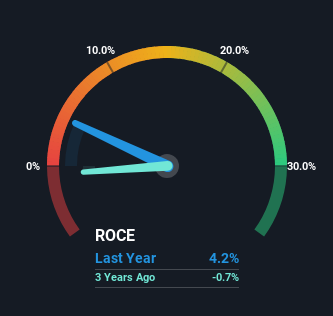- Hungary
- /
- Industrials
- /
- BUSE:OPUS
Here's What's Concerning About OPUS GLOBAL Nyrt's (BUSE:OPUS) Returns On Capital

Did you know there are some financial metrics that can provide clues of a potential multi-bagger? In a perfect world, we'd like to see a company investing more capital into its business and ideally the returns earned from that capital are also increasing. Put simply, these types of businesses are compounding machines, meaning they are continually reinvesting their earnings at ever-higher rates of return. Although, when we looked at OPUS GLOBAL Nyrt (BUSE:OPUS), it didn't seem to tick all of these boxes.
Return On Capital Employed (ROCE): What Is It?
For those who don't know, ROCE is a measure of a company's yearly pre-tax profit (its return), relative to the capital employed in the business. The formula for this calculation on OPUS GLOBAL Nyrt is:
Return on Capital Employed = Earnings Before Interest and Tax (EBIT) ÷ (Total Assets - Current Liabilities)
0.042 = Ft32b ÷ (Ft1.1t - Ft313b) (Based on the trailing twelve months to March 2023).
Therefore, OPUS GLOBAL Nyrt has an ROCE of 4.2%. In absolute terms, that's a low return and it also under-performs the Industrials industry average of 7.8%.
View our latest analysis for OPUS GLOBAL Nyrt

While the past is not representative of the future, it can be helpful to know how a company has performed historically, which is why we have this chart above. If you want to delve into the historical earnings, revenue and cash flow of OPUS GLOBAL Nyrt, check out these free graphs here.
What Can We Tell From OPUS GLOBAL Nyrt's ROCE Trend?
In terms of OPUS GLOBAL Nyrt's historical ROCE movements, the trend isn't fantastic. Around five years ago the returns on capital were 15%, but since then they've fallen to 4.2%. Although, given both revenue and the amount of assets employed in the business have increased, it could suggest the company is investing in growth, and the extra capital has led to a short-term reduction in ROCE. And if the increased capital generates additional returns, the business, and thus shareholders, will benefit in the long run.
What We Can Learn From OPUS GLOBAL Nyrt's ROCE
In summary, despite lower returns in the short term, we're encouraged to see that OPUS GLOBAL Nyrt is reinvesting for growth and has higher sales as a result. However, despite the promising trends, the stock has fallen 47% over the last five years, so there might be an opportunity here for astute investors. So we think it'd be worthwhile to look further into this stock given the trends look encouraging.
One final note, you should learn about the 3 warning signs we've spotted with OPUS GLOBAL Nyrt (including 1 which shouldn't be ignored) .
While OPUS GLOBAL Nyrt isn't earning the highest return, check out this free list of companies that are earning high returns on equity with solid balance sheets.
New: AI Stock Screener & Alerts
Our new AI Stock Screener scans the market every day to uncover opportunities.
• Dividend Powerhouses (3%+ Yield)
• Undervalued Small Caps with Insider Buying
• High growth Tech and AI Companies
Or build your own from over 50 metrics.
Have feedback on this article? Concerned about the content? Get in touch with us directly. Alternatively, email editorial-team (at) simplywallst.com.
This article by Simply Wall St is general in nature. We provide commentary based on historical data and analyst forecasts only using an unbiased methodology and our articles are not intended to be financial advice. It does not constitute a recommendation to buy or sell any stock, and does not take account of your objectives, or your financial situation. We aim to bring you long-term focused analysis driven by fundamental data. Note that our analysis may not factor in the latest price-sensitive company announcements or qualitative material. Simply Wall St has no position in any stocks mentioned.
About BUSE:OPUS
OPUS GLOBAL Nyrt
Through its subsidiaries, engages in the construction business in Hungary, Germany, Austria, Switzerland, and Montenegro, other European countries, Asia, and internationally.
Good value with proven track record.
Market Insights
Community Narratives



